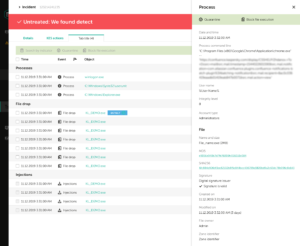
Kaspersky has sought product improvement via an integration of Kaspersky Endpoint Security, Kaspersky Endpoint Detection and Response Optimum (EDR Optimum) and Kaspersky Sandbox. The new EDR is tailored for organisations with limited security expertise and resources.
Automated EDR and sandbox capabilities
 Endpoint protection from Kaspersky is reinforced with the new Kaspersky EDR Optimum. It’s a solution specifically designed for businesses who want to benefit from having company-wide insights on incidents and the ability to respond, but without creating additional load on their teams and resources.
Endpoint protection from Kaspersky is reinforced with the new Kaspersky EDR Optimum. It’s a solution specifically designed for businesses who want to benefit from having company-wide insights on incidents and the ability to respond, but without creating additional load on their teams and resources.
Kaspersky EDR Optimum adds instant visibility across threats detected by Kaspersky Endpoint Security for Business. It provides the background for all malicious activity: enriched alert data and visualisation of the attack spread path.
If Kaspersky Endpoint Security for Business finds a suspicious file that cannot definitively be categorised as malicious, it sends it to Kaspersky Sandbox, another recently launched security tool that automatically runs the risky file in an isolated environment to make it reveal its malicious behavior or character. The verdict from Kaspersky Sandbox can then be further enriched with analytics on the file performed by Kaspersky EDR Optimum.
“Majority of business leaders rely heavily on a limited number of IT staff in their organizations to identify how and when an internal cybersecurity incident happens and how they should respond. However, in most instances, these organizations don’t have the resources and security functions in place to keep up with their cybersecurity requirements and this expands the threat surface. EDR Optimum’s consolidated approach provides instant visibility of threats, immediate investigation and advance response options”, says Margrith Appleby, General Manager of Kaspersky ANZ.
 For remediation of the threat, Kaspersky EDR Optimum introduces a wide set of response actions, such as isolating an endpoint with potential malware or quarantining a suspicious file. To ensure the threat does not spread to other machines, security specialists can create indicators of compromise (IoCs are artifacts that indicate a system has been breached) with several clicks and then schedule an automatic scan of endpoints for the malicious object. Moreover the solution allows for the uploading of third-party IoCs and running a scan to identify affected endpoints. All these functions enable centralised management of security incidents, quickly reacting to critical threats and preventing them — minimising the potential negative impact on business.
For remediation of the threat, Kaspersky EDR Optimum introduces a wide set of response actions, such as isolating an endpoint with potential malware or quarantining a suspicious file. To ensure the threat does not spread to other machines, security specialists can create indicators of compromise (IoCs are artifacts that indicate a system has been breached) with several clicks and then schedule an automatic scan of endpoints for the malicious object. Moreover the solution allows for the uploading of third-party IoCs and running a scan to identify affected endpoints. All these functions enable centralised management of security incidents, quickly reacting to critical threats and preventing them — minimising the potential negative impact on business.
As Kaspersky’s researchers found, attacks on Linux endpoint users have grown 46% in 2019 in comparison with 20183. To make sure these attacks don’t hit businesses, the new Kaspersky Endpoint Security hardens protection for endpoints on the Linux operating system. Network and web threat protection components ensure inbound and outbound traffic doesn’t contain malicious activity. Data protection is enhanced with device control, allowing it to define the rules for transferring data to other devices.
Integrated Endpoint Security also meets broader customer needs in terms of manageability. The management console Kaspersky Security Center is now available from the cloud, in addition to the existing on-premise option. Customers choosing Kaspersky Security Center Cloud Console can now deploy it faster with a lower cost of ownership while ensuring upgrades and other maintenance is managed by Kaspersky.
“The technology and cybersecurity landscape is changing rapidly, meaning organisations have to deal with more challenges using the same resources. Therefore, they need a solution that will help them to address these evolving challenges effectively — through automated detection and response capabilities. Time and human resources are key for this, and Kaspersky’s new integrated solution is designed to help businesses save on both of these by providing the key features of incident investigation and remediation,” says Dmitry Aleshin, VP, Product Marketing at Kaspersky.





